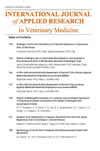Evaluation of some blood parameters in the experimental autoimmune encephalomyelitis mouse model
4区 农林科学
Q4 Veterinary
International Journal of Applied Research in Veterinary Medicine
Pub Date : 2021-10-29
DOI:10.30782/jrvm.936948
引用次数: 0
Abstract
Multiple sclerosis (MS) is a chronic neuroinflammatory demyelinating disorder of the central nervous system with unclear exact etiology. The experimental autoimmune encephalomyelitis (EAE) model in C57BL/6 mice is the most common animal model for MS sharing many clinical and pathophysiological features to expand our knowledge on the pathophysiology of the disease and to develop novel treatment strategies. The current study was designed to determine hematological parameters and plasma total protein (TP) and albumin (ALB) levels in EAE-in-duced C57BL/6 mice to help researchers working on the EAE animal model. EAE was induced with myelin oligodendrocyte glycoprotein (MOG35-55) peptide in the female C57BL/6 mice. The EAE clinically caused paralyzed tail, hind limb paresis, and uncoordinated movement in the mice. The EAE-induced mice hematologically had a statistically significant mild increase in white blood cell (WBC) count without altering neutrophil-lymphocyte ratio but no change in vital hematological parameters such as red blood cell count, packed cell volume, and hemoglobin level. Moreover, the EAE led to an increase in the plasma TP level and attenuation in plasma ALB level in the mice. In conclusion, our findings show that the EAE model in mice might not cause any significant change hematologically, except a slight increase in the WBC count, and might produce changes in the plasma protein level. As the findings of the current study, the EAE-induced blood parameter effects could consider understanding the pathophysiology of the disease and developing a novel therapeutic approach for the disease实验性自身免疫性脑脊髓炎小鼠模型一些血液参数的评价
多发性硬化症(MS)是一种中枢神经系统的慢性神经炎性脱髓鞘疾病,确切病因尚不清楚。C57BL/6小鼠的实验性自身免疫性脑脊髓炎(EAE)模型是MS最常见的动物模型,具有许多临床和病理生理特征,可以扩展我们对疾病病理生理的认识,并制定新的治疗策略。本研究旨在测定EAE诱导的C57BL/6小鼠的血液学参数和血浆总蛋白(TP)和白蛋白(ALB)水平,以帮助研究人员建立EAE动物模型。用髓鞘少突胶质细胞糖蛋白(MOG35-55)肽诱导雌性C57BL/6小鼠EAE。EAE在临床上引起小鼠尾麻痹、后肢麻痹、运动不协调。eae诱导小鼠血液学上有统计学意义的白细胞(WBC)计数轻度增加,但中性粒细胞与淋巴细胞的比例没有改变,但红细胞计数、堆积细胞体积和血红蛋白水平等重要血液学参数没有变化。此外,EAE导致小鼠血浆TP水平升高,血浆ALB水平降低。综上所述,我们的研究结果表明,小鼠EAE模型除了白细胞计数略有增加外,可能不会引起血液学上的任何显著变化,并可能引起血浆蛋白水平的变化。正如本研究的发现,eae诱导的血液参数效应可以考虑了解疾病的病理生理,并为疾病的治疗开辟新的途径
本文章由计算机程序翻译,如有差异,请以英文原文为准。
求助全文
约1分钟内获得全文
求助全文
来源期刊
自引率
0.00%
发文量
1
审稿时长
3 months
期刊介绍:
The International Journal of Applied Research in Veterinary Medicine promotes excellence in the clinical practice of veterinary medicine by disseminating fundamental scientific, diagnostic, and treatment knowledge gained from prospective and retrospective research in a timely manner. The Journal fulfills its mission through rapid peer review of each submitted article, and publication of all articles within 90 days of acceptance. All published articles meet the standards of Balance, Independence, Objectivity and Scientific Rigor.

 求助内容:
求助内容: 应助结果提醒方式:
应助结果提醒方式:


